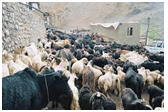Antibiotic Drugs On livestock
News: The following are the results of a survey conducted by the National Institute of Standards and Technology (NIST) on the use of standardised test procedures for evaluating the quality of scientific publications.
The usage of veterinary antibiotics on animals, such as tetracycline, was revealed to be the likely cause of this disparity, according to researchers.
According to the researchers, these antibiotics affect the microbial populations in the soil in ways that are harmful for sequestering carbon when they are introduced into the soil through dung and urine.
According to the study, despite many similarities between the soils from the wild and livestock areas, there was one significant factor—the carbon use efficiency, or CUE—that set them apart. The CUE measures how well soil microbes can store carbon.
The soil’s CUE was 19% lower in the cattle regions.
Tetracycline is a long-lasting antibiotic that can persist in the soil for many years.
It is “off label” or “extra label” when used to treat bacterial infections or other illnesses in cats, dogs, small mammals, horses, or birds.




